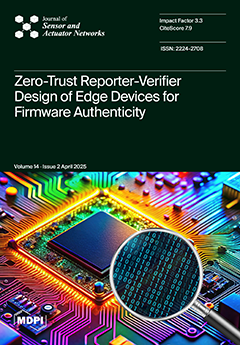We introduce a robust distributed collaborative beamforming (RDCB) approach for addressing channel estimation challenges in dual-hop transmissions within wireless sensor and actuator networks (WSANs) of
K nodes. WSANs enhance wireless communication by reducing data transmission, latency, and energy consumption while optimizing network load
[...] Read more.
We introduce a robust distributed collaborative beamforming (RDCB) approach for addressing channel estimation challenges in dual-hop transmissions within wireless sensor and actuator networks (WSANs) of
K nodes. WSANs enhance wireless communication by reducing data transmission, latency, and energy consumption while optimizing network load through integrated sensing and actuation. The source
S transmits signals to the WSAN, where nodes relay them to the destination
D using beamforming weights to minimize noise and preserve signal integrity. These weights depend on channel state information (CSI), where estimation errors degrade performance. We develop RDCB solutions for three first-hop propagation scenarios—monochromatic [line-of-sight (LoS)] or “M”, bichromatic (moderately scattered) or “B”, and polychromatic (highly scattered) or “P”—while assuming a monochromatic LoS or “M” link for the second hop between the nodes and the far-field destination. Termed MM-RDCB, BM-RDCB, and PM-RDCB, respectively (“X” and “Y” in XY-RDCB—for X
and Y
—refer to the chromatic natures of the first- and second-hop channels, respectively, to which a specific RDCB solution is tailored), these solutions leverage asymptotic approximations for large
K values and the nodes’ geometric symmetries. Our distributed solutions allow local weight computation, enhancing spectral and power efficiency. Simulation results show significant improvements in the signal-to-noise ratio (SNR) and robustness versus WSAN node placement errors, making the solutions well suited for emerging 5G and future 5G+/6G and Internet of Things (IoT) applications for different challenging environments.
Full article





